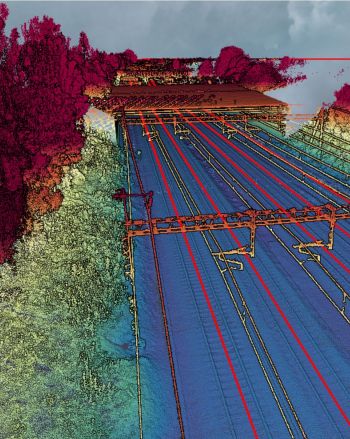Network Rail holds a vast amount of information on its network assets. The challenge is to
accurately visualise, interpret and share this data throughout the company, unearthing the most
useful operational insight to improve passenger experience. Through its engagement with Fujitsu
Labs, Network Rail has developed an Artificial Intelligence (AI) tool to automatically identify,
catalogue and visualise a number of assets and their location. This will help identify faults and
save engineers time when undertaking surveys.
Challenge
Transform the way critical network asset data is verified, visualized and exploited among project teams.
Solution
AI tool that automatically recognizes and catalogs assets and their attributes.
Outcomes
- Recognized and cataloged assets automatically with AI-trained models
- Repaired assets more quickly
- Enabled the scheduling of proactive maintenance Network-Rail
- Improved ability to plan upgrades.
The railway is built on a legacy linear measurement system. We need to modernise and show our asset base geospatially.
Chris Stanley, Regional Asset Data & Analysis Manager, Network Rail
About the customer
Network Rail owns, operates and develops Britain’s railway infrastructure. This includes 20,000 miles of track; 40,000 bridges, tunnels and viaducts; 20 major stations; and the thousands of signals and level crossings. It expects to invest a total of £357M in Research, Development & Innovation through its five year control period to drive improvements in efficiency and safety through new technology.
Modernising a nation’s rail infrastructure
Network Rail manages Britain’s rail infrastructure. Everyday nearly five million journeys are made on the rail network. This network carries freight, and passengers. It connects workplaces and communities.
It is not enough for Network Rail to manage the existing network, it must plan and deliver a rail network for the future. This is a huge task.
“The railway is built on a legacy linear measurement system,” says Chris Stanley, Regional Asset Data & Analysis Manager at Network Rail. “We need to modernise and show our asset base geospatially.”
Network Rail’s approach to asset tracking lacked consistency and continued to rely on manual surveys and processes established in the Victorian era. Where there were Light Detection and Ranging (LiDAR) scans, the data was huge and unwieldy. It wanted to transform the way it found insight in data, and how data could be shared and visualised among project teams. By better leveraging its data, Network Rail will be able to make smarter decisions, ultimately improving the rail experience for passengers
Using Artificial Intelligence to model network assets
Following success at the HackTrain VI event, Fujitsu began working with Network Rail’s Research and Development Portfolio as an agile co-creation partner to transform its approach to verifying the accuracy of its asset data.
Over an 18-week period, and across a series of two-week sprints, Fujitsu software engineers assisted by AI specialists from Fujitsu Laboratories and Network Rail domain specialists developed a 3D user interface which extracts and visualises optical video and 3D LiDAR point cloud data, enabling the use of integrated measurement tools and AI models which are trained to automatically recognise and catalogue assets and their attributes through recognising their inherent features.
Through post data capture, Fujitsu can provide highly accurate asset positioning vital to Network Rail project planning and works verification. New insights can then be used by Network Rail to verify,and if necessary, correct asset management information to improve the accuracy and understanding of its data.
“The agile way of working was new to us, and it’s a steep learning curve,” says John Nolan, Programme Manager BIM, Network Rail. “I don’t think a waterfall approach would have worked with this project, but agile would not have been possible without Fujitsu’s leadership. It was a brilliant experience."
Data insight to drive safety and improve passenger experience
The engagement has made significant progress towards providing Network Rail with an AI asset recognition model and user interface, Railway Asset Identification System (RAIS), capable of making sense of its huge estate of assets. The benefit of the tool could potentially mean that it can locate assets quickly helping to fix faults, be more proactive in service scheduling and better able to plan repairs and upgrades.
The overall result is improved passenger experience, fewer delays and higher safety standards. “Having a digital map of our network will ultimately help passengers,” says Stanley. “We’re helping to build a network fit for the future.









